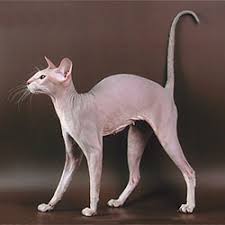
Peterbald
Conditions of detention
Peterbalds thrive in indoor environments where they can be protected from extreme temperatures, as their lack of fur makes them sensitive to both cold and direct sunlight. They enjoy interactive play and require an environment where they can engage with their human companions.
Useful Fact:
Peterbalds are highly social and thrive in households where they receive plenty of attention and interaction. They form strong bonds with their human families and enjoy being part of daily activities.
Nutrition and diet
Peterbalds require a balanced diet rich in high-quality protein to support their lean and muscular build. Both wet and dry food should be provided to ensure hydration and dental health. Monitoring their food intake is crucial to prevent overfeeding and maintain their optimal weight.
Useful Fact: Peterbalds have a high metabolism due to their active nature, so they may require more frequent feeding compared to less active breeds.
Health
Peterbalds are generally healthy but can be prone to common feline health issues such as dental problems and skin conditions. Regular veterinary check-ups are important to monitor their overall health and catch any issues early.
Useful Fact: Due to their lack of fur, Peterbalds are more susceptible to temperature changes and should be kept warm, especially in colder climates.
Grooming and care
Their hairless or very short coat requires minimal grooming, but regular bathing is necessary to remove oil buildup on their skin. It’s also important to clean their ears and trim their nails regularly.
Useful Fact: Peterbalds benefit from gentle skincare products to keep their skin healthy and free from irritation.
Education and training
Peterbalds are highly intelligent and can be trained to follow basic commands and use a litter box efficiently. Positive reinforcement techniques, such as treats and praise, are effective in training this breed.
Useful Fact: Their intelligence and curiosity make Peterbalds quick learners who can enjoy interactive toys and puzzle feeders.
Toys and entertainment
These active and playful cats enjoy a variety of toys, including feather wands, interactive toys, and puzzle feeders. They appreciate climbing structures and enjoy high perches to survey their surroundings.
Useful Fact: Peterbalds thrive on mental stimulation and can become bored without adequate playtime and enrichment.
Safety
Peterbalds should be kept indoors or in a secure outdoor enclosure to protect them from potential dangers such as traffic, predators, and diseases. Microchipping and providing identification tags are essential for their safety.
Useful Fact: Their lack of fur makes them more vulnerable to sunburn, so it’s important to limit their sun exposure or use pet-safe sunscreen.
Accessories
Essential accessories for Peterbalds include a comfortable bed, high-quality scratching posts, a variety of toys, and a sturdy cat carrier for travel. Soft blankets and heated beds can help keep them warm.
Useful Fact: Investing in heated pet beds can help keep Peterbalds comfortable, especially in cooler environments.
Socialization
Peterbalds are highly sociable and thrive on human interaction. They get along well with children and other pets. Early socialization helps them become well-adjusted and confident adults.
Useful Fact: Peterbalds often form strong bonds with their owners and can become lonely if left alone for long periods.
Travel and Transportation
When traveling, use a secure and comfortable cat carrier. Familiarizing your Peterbald with the carrier before trips can reduce stress. Ensure they have access to water and take breaks during long journeys.
Useful Fact: Bringing familiar items like a favorite blanket or toy can help reduce anxiety during travel.
Behavior and psychology
Peterbalds are known for their affectionate, playful, and curious nature. They enjoy exploring their environment and interacting with their human companions. Their social and outgoing personality makes them excellent pets.
Useful Fact: Peterbalds often display dog-like behavior, following their owners around the house and seeking constant companionship.
Legal aspects
Ensure your Peterbald is up-to-date on vaccinations and registered according to local regulations. Spaying or neutering is recommended to prevent unwanted litters and reduce certain health risks.
Useful Fact: Many regions require cats to be microchipped and wear identification tags, which can help in reuniting lost pets with their owners.


